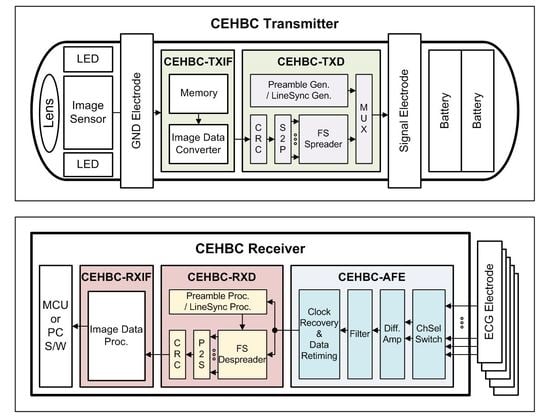Low-Power, High Data-Rate Digital Capsule Endoscopy Using Human Body Communication
Abstract
:1. Introduction
2. CEHBC System Architecture
2.1. CEHBC System
2.2. CEHBC Physical Structure
2.3. CEHBC Data Frame Structure
3. Techniques to Improve Performance in the CEHBC System
3.1. Frequency Selective Digital Transmission
3.2. Selection Algorithm of the Electrode
3.3. LineSync Algorithm
4. CEHBC System Measurement and Performance
4.1. Measurement Environment of the CEHBC System
4.2. Performance of the CEHBC System
5. Discussion
6. Conclusions
Author Contributions
Funding
Acknowledgments
Conflicts of Interest
References
- Ciuti, G.; Menciassi, A.; Dario, P. Capsule endoscopy: From current achievements to open challenges. IEEE Rev. Biomed. Eng. 2011, 4, 59–72. [Google Scholar] [CrossRef] [PubMed]
- Gao, Y.; Cheng, S.-J.; Toh, W.-D.; Kwok, Y.-S.; Tan, K.-C.B.; Chen, X.; Mok, W.-M.; Win, H.-H.; Zhao, B.; Diao, S.; et al. An asymmetrical QPSK/OOK transceiver SoC and 15:1 JPEG encoder IC for multifunction wireless capsule endoscopy. IEEE J. Solid-State Circuits 2013, 48, 2717–2733. [Google Scholar] [CrossRef]
- Chi, B.; Yao, J.; Han, S.; Xie, X.; Li, G.; Wang, Z. Low-power transceiver analog front-end circuits for bidirectional high data rate wireless telemetry in medical endoscopy applications. IEEE Trans. Biomed. Eng. 2007, 54, 1291–1299. [Google Scholar] [PubMed]
- Iddan, G.; Meron, G.; Glukhovsky, A.; Swain, P. Wireless capsule endoscopy. Nature 2000, 405, 417–418. [Google Scholar] [CrossRef] [PubMed]
- Liu, L.; Towfighian, S.; Hila, A. A review of locomotion systems for capsule endoscopy. IEEE Rev. Biomed. Eng. 2015, 8, 138–151. [Google Scholar] [CrossRef] [PubMed]
- Karargyris, A.; Koulaouzidis, A. OdoCapsule: Next-generation wireless capsule endoscopy with accurate lesion localization and video stabilization capabilities. IEEE Trans. Biomed. Eng. 2015, 62, 352–360. [Google Scholar] [CrossRef] [PubMed]
- Woods, S.P.; Constandinou, T.G. Wireless capsule endoscope for targeted drug delivery: mechanics and design considerations. IEEE Trans. Biomed. Eng. 2013, 60, 945–953. [Google Scholar] [CrossRef] [PubMed]
- De Falco, I.; Tortora, G.; Dario, P.; Menciassi, A. An integrated system for wireless capsule endoscopy in a liquid-distended stomach. IEEE Trans. Biomed. Eng. 2014, 61, 794–804. [Google Scholar] [CrossRef] [PubMed]
- Turcza, P.; Duplaga, M. Hardware-efficient low-power image processing system for wireless capsule endoscopy. IEEE J. Biomed. Health Inf. 2013, 17, 1046–1056. [Google Scholar] [CrossRef] [PubMed]
- Khan, T.H.; Shrestha, R.; Wahid, K.A.; Babyn, P. Design of a smart-device and FPGA based wireless capsule endoscopic system. Sens. Actuators 2015, 221, 77–87. [Google Scholar] [CrossRef]
- Kim, K.; Yun, S.; Lee, S.; Nam, S.; Yoon, Y.J.; Cheon, C. A design of a high-speed and high efficiency capsule endoscopy system. IEEE Trans. Biomed. Eng. 2012, 59, 1005–1011. [Google Scholar] [PubMed]
- Thotahewa, K.M.S.; Redoute, J.M.; Yuce, M.R. A UWB Wireless Capsule Endoscopy Device. In Proceedings of the 2014 36th Annual International Conference of the IEEE Engineering in Medicine and Biology Society, Chicago, IL, USA, 26–30 August 2014; IEEE: New York, NY, USA, 2014. [Google Scholar]
- Thotahewa, K.M.S.; Redoute, J.M.; Yuce, M.R. Propagation, power absorption, and temperature analysis of UWB wireless capsule endoscopy devices operating in the human body. IEEE Trans. Microwave Theory Tech. 2015, 63, 3826–3833. [Google Scholar] [CrossRef]
- Brumm, J.C.; Bauch, G. On the placement of On-Body antennas for ultra wideband capsule endoscopy. IEEE Access 2017, 5, 10141–10149. [Google Scholar] [CrossRef]
- Goh, S.T.; Zekavat, S.A.R.; Pahlavan, K. DOA-based endsoscopy capsule localization and orientation estimation via unscented kalman filter. IEEE Sens. J. 2014, 14, 3819–3829. [Google Scholar]
- Nafchi, A.R.; Goh, S.T.; Zekavat, S.A.R. Circular arrays and inertial measurement unit for DOA/TOA/TDOA-based endoscopy capsule localization: Performance and complexity investigation. IEEE Sens. J. 2014, 14, 3791–3799. [Google Scholar] [CrossRef]
- Swar, P.; Ye, Y.; Ghaboosi, K.; Pahlavan, K. On Effect of Transmit Power Variance on Localization Accuracy in Wireless Capsule Endoscopy. In Proceedings of the IEEE Wireless Communication and Networking Conference, Shanghai, China, 1–4 April 2012; IEEE: New York, NY, USA, 2012. [Google Scholar]
- Hou, J.; Zhu, Y.; Zhang, L.; Fu, Y.; Zhao, F.; Yang, L.; Rong, G. Design and Implementation of a High Resolution Localization System for In-Vivo Capsule Endoscopy. In Proceedings of the 2009 Eighth IEEE International Conference on Dependable, Autonomic and Secure Computing, Chengdu, China, 12–14 December 2009; IEEE: New York, NY, USA, 2009. [Google Scholar]
- Hyoung, C.H.; Kang, S.W.; Park, S.O.; Kim, Y.T. Transceiver for human body communication using frequency selective digital transmission. Electron. Telecommun. Res. Int. 2012, 34, 216–225. [Google Scholar] [CrossRef]
- Ho, C.K.; Cheong, J.H.; Lee, J.; Kulkarni, V.; Li, P.; Liu, X.; Je, M. High bandwidth efficiency and low power consumption Walsh code implementation methods for body channel communication. IEEE Trans. Microwave Theory Tech. 2014, 62, 1867–1878. [Google Scholar] [CrossRef]
- Hwang, J.-H.; Kang, T.-W.; Kim, Y.-T.; Park, S.-O. Analysis on co-channel interference of human body communication supporting IEEE 802.15.6 BAN standard. Electron. Telecommun. Res. Int. 2015, 37, 439–449. [Google Scholar]
- MiroCam Capsule Endoscope System User Manual User Manual Intromedic Co., Ltd. Available online: https://fccid.io/VAXINTROMEDIC3/User-Manual/Users-Manual-1476111 (accessed on 13 July 2018).
- Hwang, W.J.; Kim, K.Y.; Choi, H.-J. Enhanced common-mode noise rejection method based on impedance mismatching compensation for wireless capsule endoscopy systems. Electron. Telecommun. Res. Int. 2015, 37, 637–645. [Google Scholar] [CrossRef]
- Zhang, K.; Hao, Q.; Song, Y.; Wang, J.; Huang, R.; Liu, Y. Modeling and characterization of the implant intra-body communication based on capacitive coupling using a transfer function method. Sensors 2014, 14, 1740–1756. [Google Scholar] [CrossRef] [PubMed]
- Hachisuka, K.; Takeda, T.; Terauchi, Y.; Sasaki, K.; Hosaka, H.; Itao, K. Intra-body data transmission for the personal area network. Microsyst. Technol. 2005, 11, 1020–1027. [Google Scholar] [CrossRef]
- Lee, S.H.; Lee, J.; Yoon, Y.J.; Park, S.; Cheon, C.; Kim, K.; Nam, S. A wideband spiral antenna for ingestible capsule endoscope systems: Experimental results in a human phantom and a pig. IEEE Trans. Biomed. Eng. 2011, 58, 1734–1741. [Google Scholar] [PubMed]
- Li, Z.; Ren, B.; Tan, H.; Liu, S.; Wang, W.; Pang, Y.; Lin, J.; Zeng, C. Capsule design for blue light therapy against helicobacter pylori. PLoS ONE 2016, 11, 1–10. [Google Scholar] [CrossRef] [PubMed]
- Akyildiz, I.F.; Pierobon, M.; Balasubramaniam, S.; Koucheryavy, Y. The internet of bio-nano things. IEEE Commun. Mag. 2015, 53, 32–40. [Google Scholar] [CrossRef]

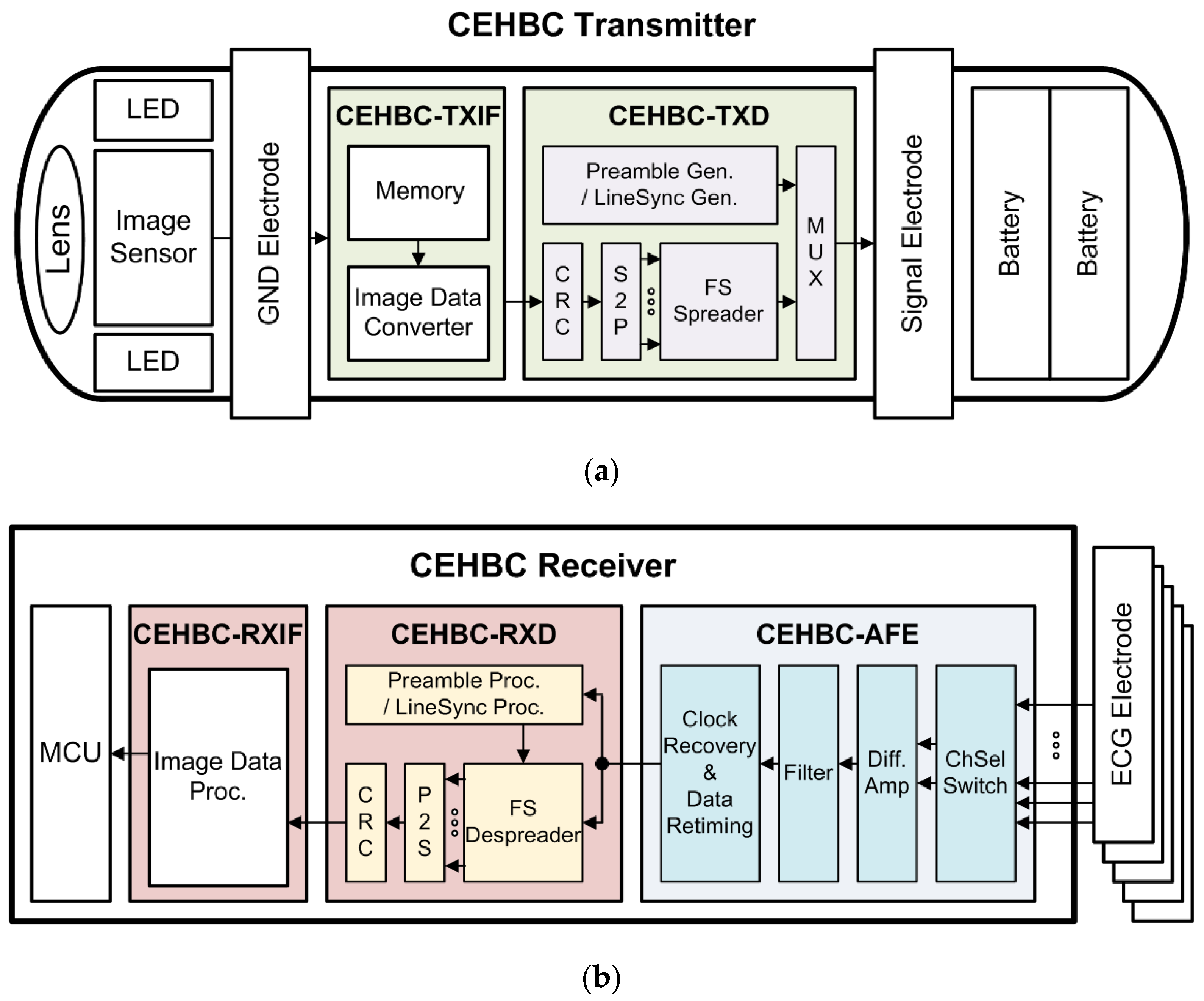
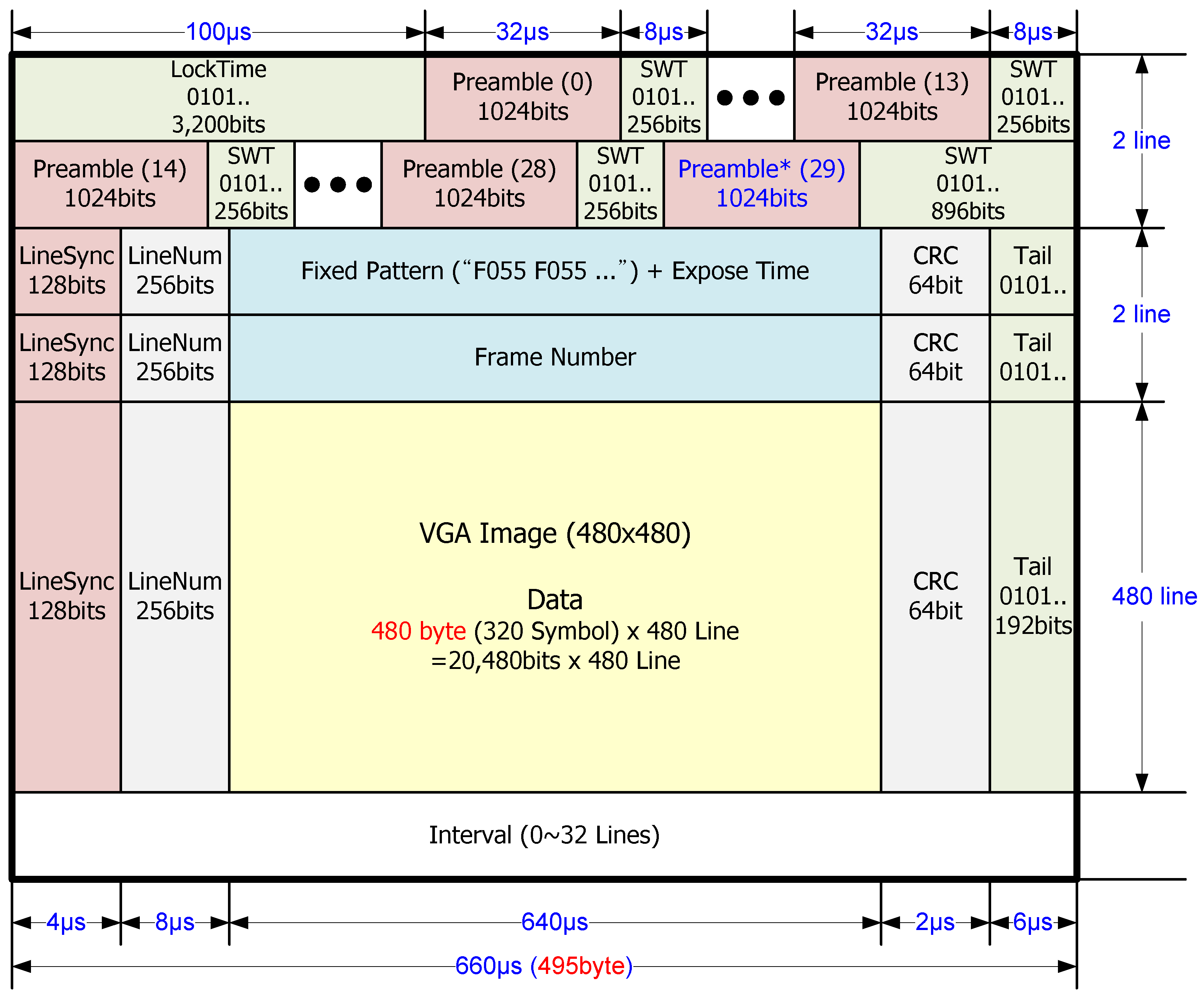
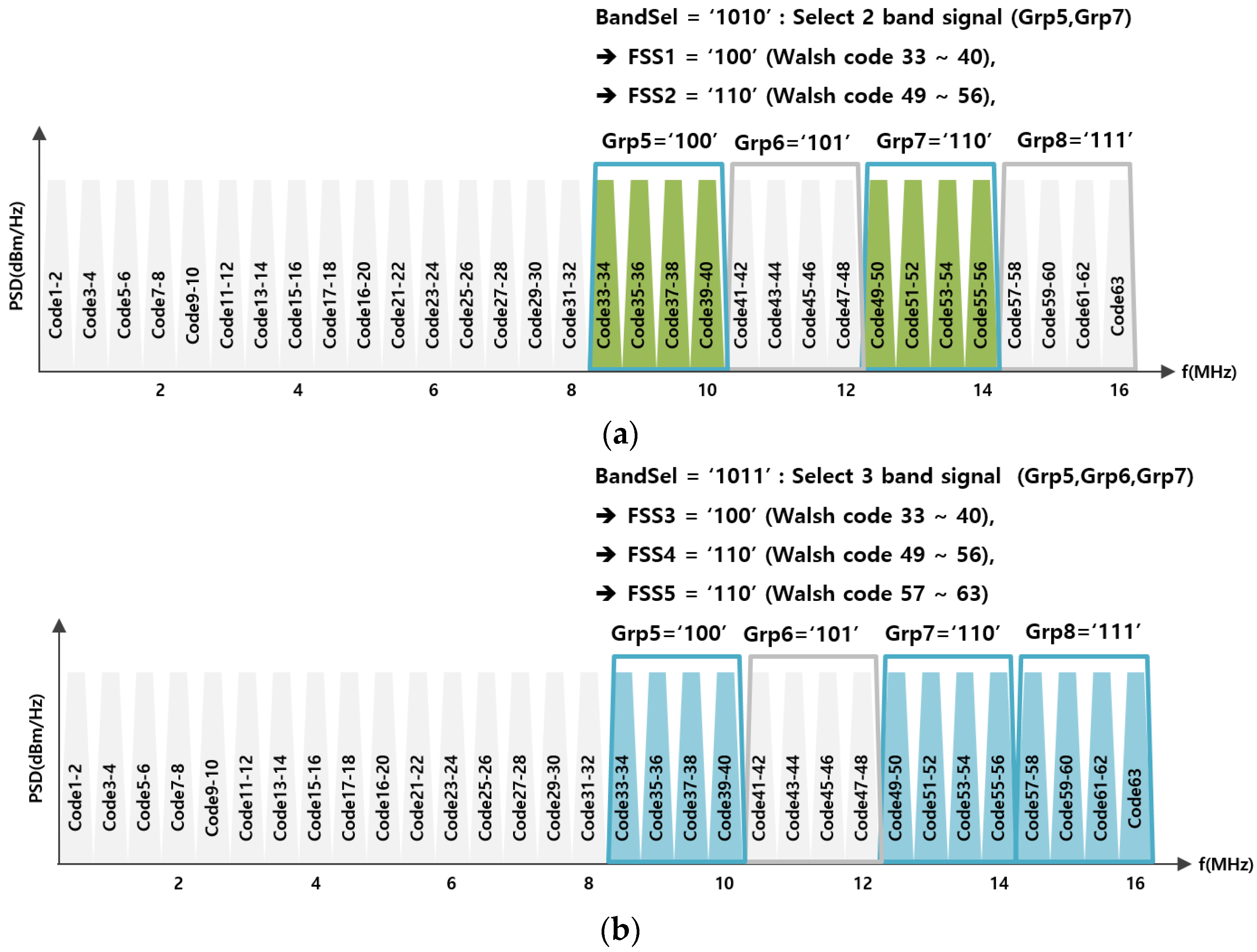
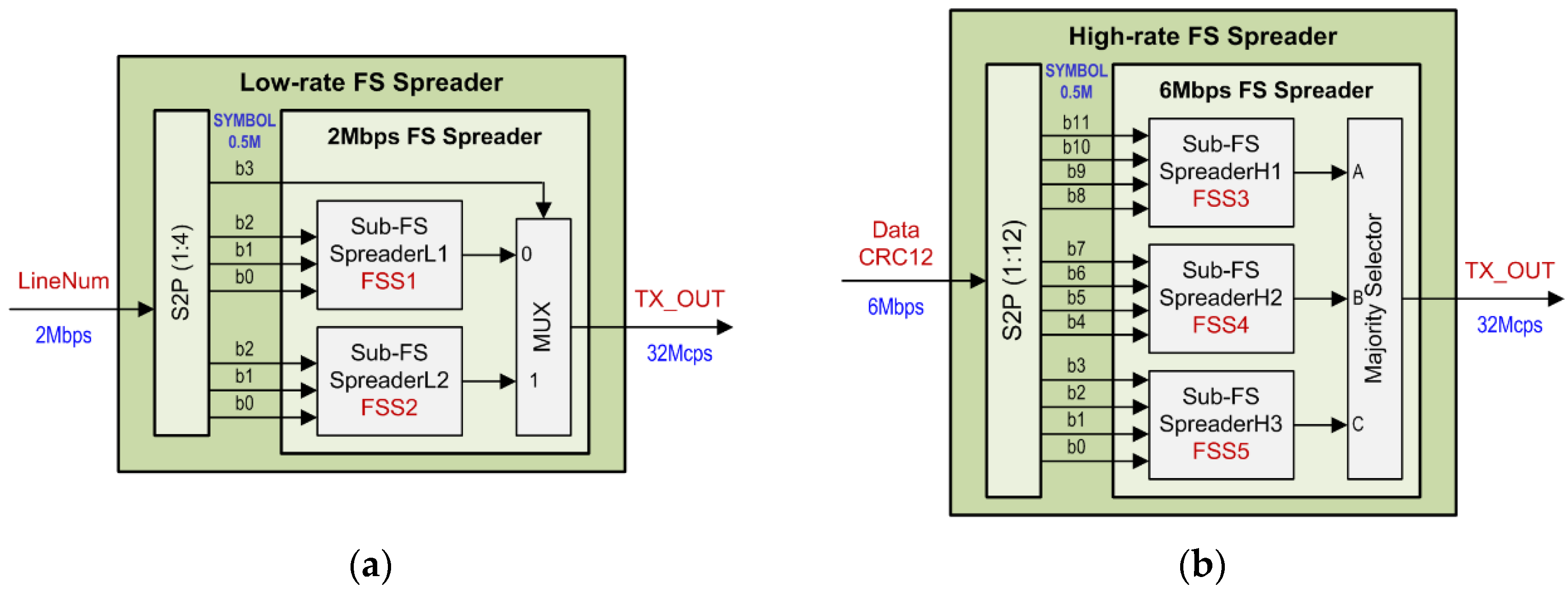
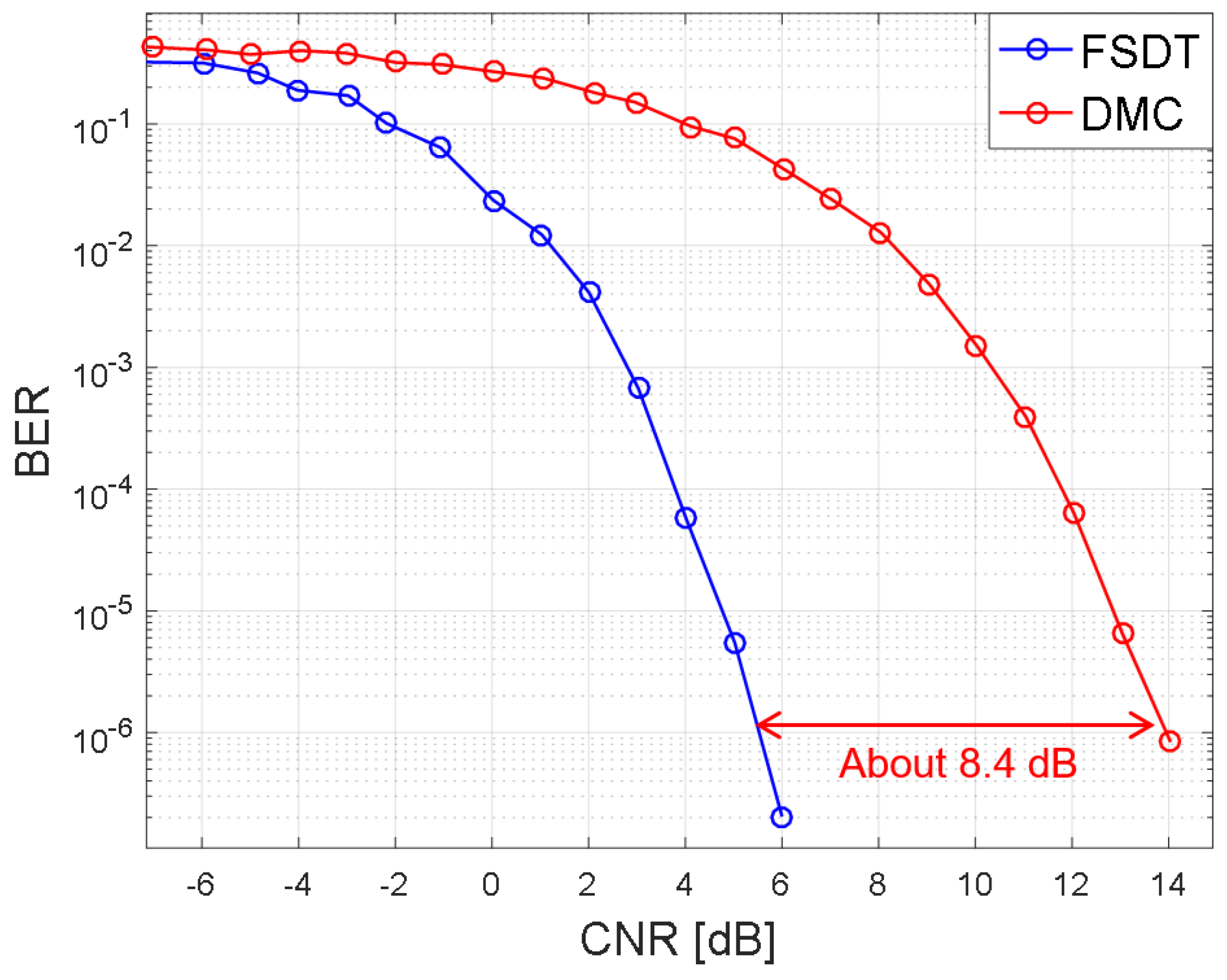
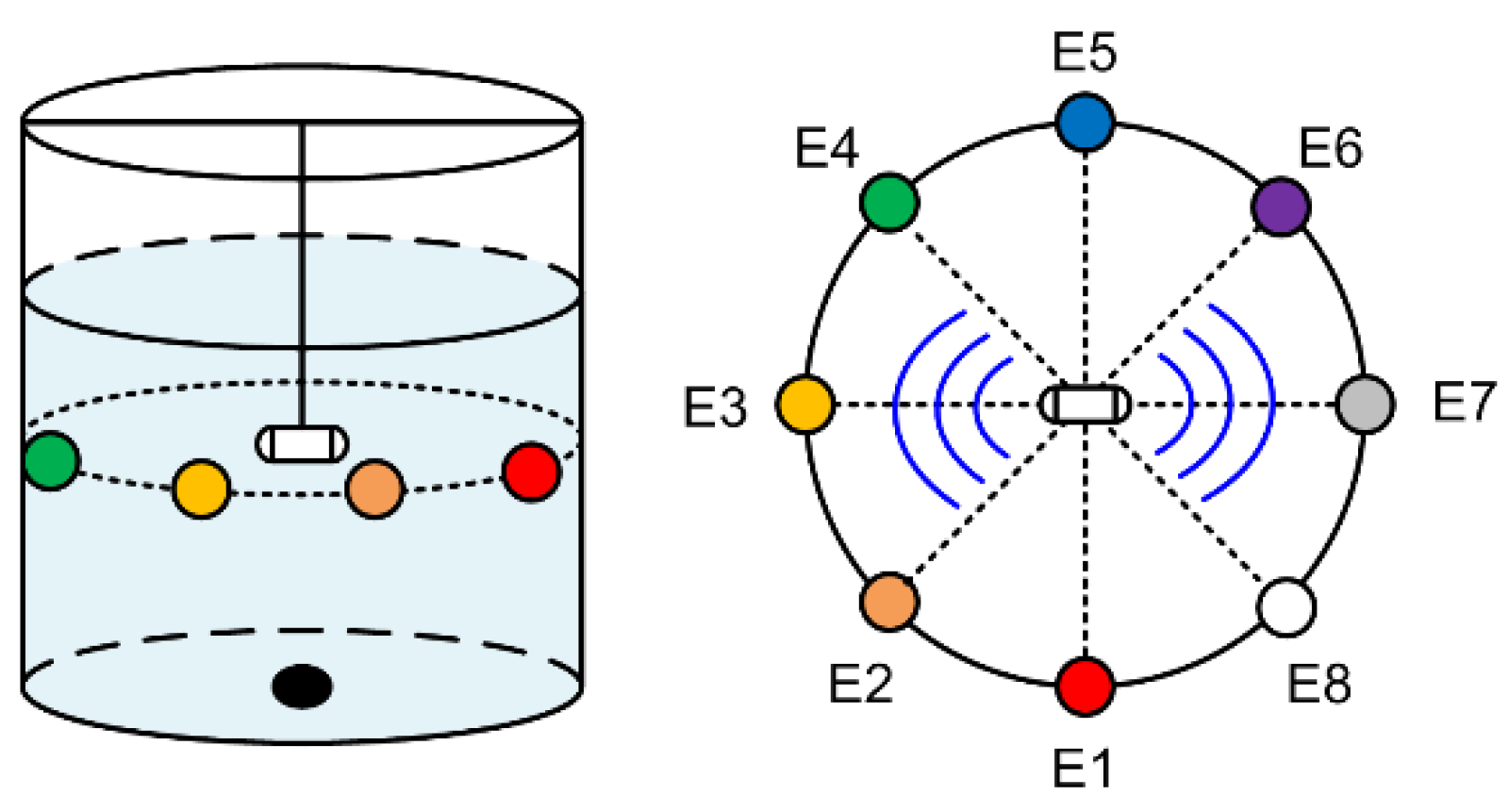
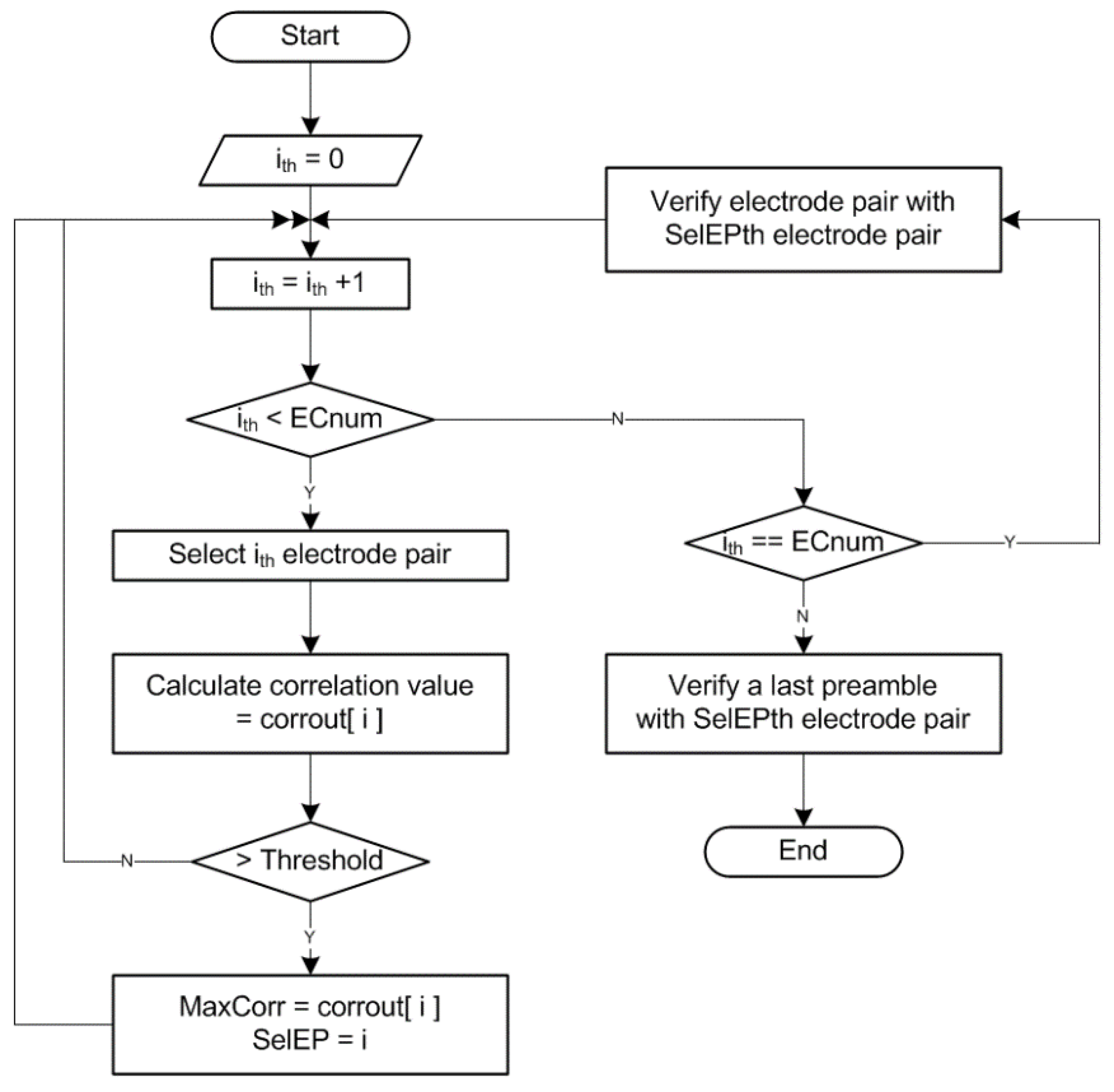
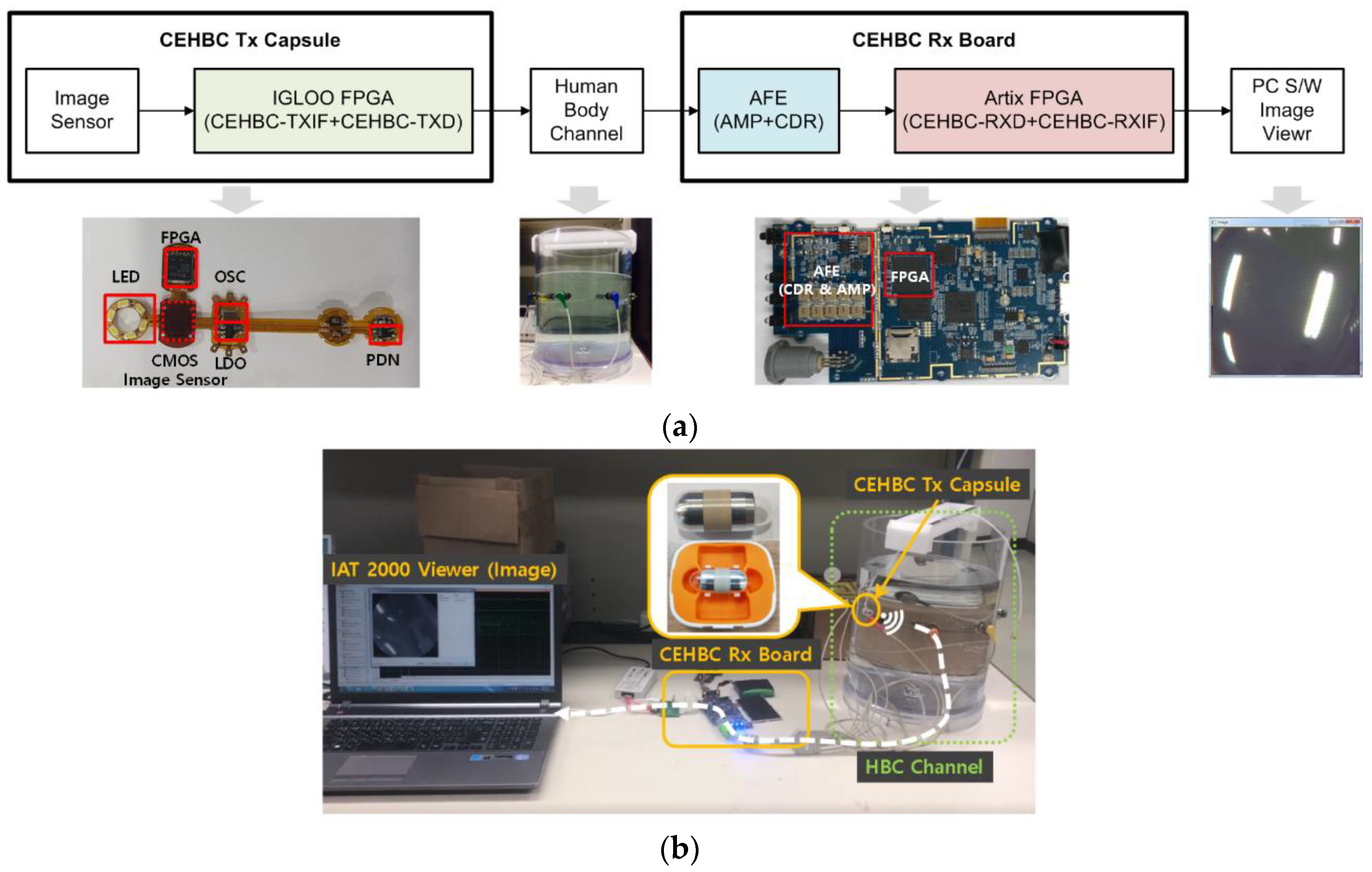
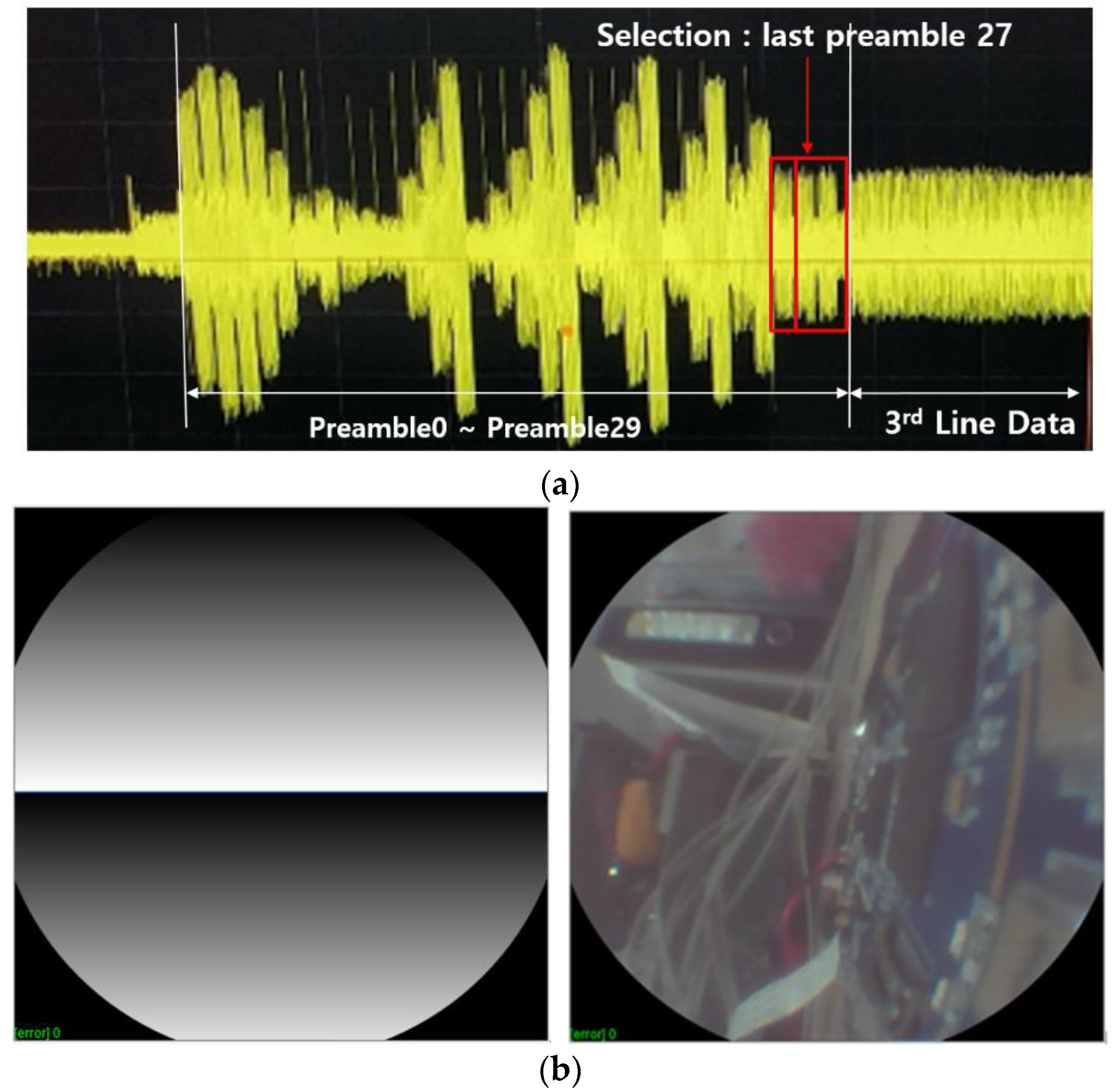
| Parameters | Description |
|---|---|
| application | Inbody-to-Onbody (capsule endoscopy) |
| main clock frequency | 32 MHz |
| modulation | direct digital frequency selective digital transmission (64 b Walsh code) |
| frequency band | 8–16 MHz |
| resolution | image data 480 × 480 byte (3.13 f/s) |
| frame Length | 319,440 µs |
| data rate | maximum 6 Mbps |
| preamble | combination of short preamble and long preamble |
| linesync | 5-bit pseudo-random noise (PN) code |
| cyclic redundancy check (CRC) | CRC-12 polynomial |
| Case ith | Selected Electrode 1 | Selected Electrode 2 | Case ith | Selected Electrode 1 | Selected Electrode 2 |
|---|---|---|---|---|---|
| 0 | E1 | E2 | 14 | E3 | E5 |
| 1 | E1 | E3 | 15 | E3 | E6 |
| 2 | E1 | E4 | 16 | E3 | E7 |
| 3 | E1 | E5 | 17 | E3 | E8 |
| 4 | E1 | E6 | 18 | E4 | E5 |
| 5 | E1 | E7 | 19 | E4 | E6 |
| 6 | E1 | E8 | 20 | E4 | E7 |
| 7 | E2 | E3 | 21 | E4 | E8 |
| 8 | E2 | E4 | 22 | E5 | E6 |
| 9 | E2 | E5 | 23 | E5 | E7 |
| 10 | E2 | E6 | 24 | E5 | E8 |
| 11 | E2 | E7 | 25 | E6 | E7 |
| 12 | E2 | E8 | 26 | E6 | E8 |
| 13 | E3 | E4 | 27 | E7 | E8 |
| CEHBC Tx field Programmable Gate Array (FPGA) Block (CEHBC-Tx Interface (TXIF) & CEHBC-Tx Digital (TXD)) | CEHBC Rx FPGA Block (CEHBC-RXD & CEHBC-RXIF) | |
|---|---|---|
| field programmable gate array (FPGA) | Actel IGLOO AGLN125V5-CS81 | Xilinx Artix 7 XC7A50T-CSG324 |
| synthesis and Download tool | Libero v11.8 | Vivado 2015.3 |
| logic size | CEHBC-TXIF Core: 1084 of 3072 (35.29%) CEHBC-TXD Core: 521 of 3072 (16.96%) | Resource Utilization (LUT) 5231 of 32,600 (16.05%) |
| input/output voltage level | LVCMOS 3.3V | LVCMOS 3.3V |
| power consumption | CEHBC-TXIF:2.63 mW CEHBC-TXD:3.71 mW | 114 mW |
| main clock frequency | 32 MHz | 32 MHz |
| Distance between Electrodes and Capsule Endoscope | The Direction of the Capsule Endoscope towards the Electrode | |||||||
|---|---|---|---|---|---|---|---|---|
| E1 | E2 | E3 | E4 | E5 | E6 | E7 | E8 | |
| 6 cm | 0 | 0 | 0 | 0 | 0 | 0 | 0 | 0 |
| 11 cm | 0 | 0 | 0 | 0 | 0 | 0 | 0 | 0 |
| 2007 [3] | 2013 [2] | 2015 [10] | This | |
|---|---|---|---|---|
| Application | Capsule Endoscopy | |||
| data rate before image compression | 1 Mbps | 3~20 Mbps | 8 Mbps | 6 Mbps |
| image compression | X | (lossy) | (lossless/lossy) | X |
| compression ratio | – | 93% (1:15) | >75% (1:4) | – |
| data rate after image compression | 1 Mbps | 1.34 Mbps | 2 Mbps | 6 Mbps |
| communication | RF | RF | RF | HBC |
| carrier frequency | 2.4 GHz | 920/925 MHz | 2.4 GHz | 32 MHz |
| modulation | Amplitude Shift Keying (ASK) | Quadrature Phase Shift Keying (QPSK) | Gaussian Minimum Shift Keying (GMSK) | Frequency Selective Digital Transmission (FSDT) |
| technology | CMOS 250 nm | CMOS 180 nm | – | FPGA 130 nm (AGLN125V5) |
| power consumption | 7.925 mW | 2.5 mW | – | 3.7 mW |
| energy consumption | 7.925 nJ/bit | 1.865 nJ/bit | – | 0.616 nJ/bit |
| resolution | – | 640 × 480 | 320 × 240 160 × 120 128 × 96 | 480×480 |
| frame rate | – | 3 f/s | 55 f/s | 3.13 f/s |
| Specification | MiroCam [1,22] | CEHBC Tx Capsule |
|---|---|---|
| communication | human body communication | |
| image sensor | customized CMOS image sensor with 320 × 320 pixel array) | PIXERPLUS PO8030D VGS single chip CMOS image sensor with 640 × 480 pixel array |
| pixel | 102,400 (=320 × 320) | 230,400 (=480 × 480) |
| frame rate | 3 frames/s | 3.13 frame/s |
| data rate | 3 Mbps | 6 Mbps |
| field of view | 150 degrees | – |
| battery | – | 3 V, 160 mAh Coin battery |
| battery life | 11 h | 8.3 h |
| lighting | 6 LEDs | 6 LEDs |
| size | 11 × 24 mm | 13 × 27 mm |
| weight | 3.4 ± 0.05 g | 6.1 g |
© 2018 by the authors. Licensee MDPI, Basel, Switzerland. This article is an open access article distributed under the terms and conditions of the Creative Commons Attribution (CC BY) license (http://creativecommons.org/licenses/by/4.0/).
Share and Cite
Park, M.J.; Kang, T.; Lim, I.G.; Oh, K.-I.; Kim, S.-E.; Lee, J.-J.; Park, H.-I. Low-Power, High Data-Rate Digital Capsule Endoscopy Using Human Body Communication. Appl. Sci. 2018, 8, 1414. https://doi.org/10.3390/app8091414
Park MJ, Kang T, Lim IG, Oh K-I, Kim S-E, Lee J-J, Park H-I. Low-Power, High Data-Rate Digital Capsule Endoscopy Using Human Body Communication. Applied Sciences. 2018; 8(9):1414. https://doi.org/10.3390/app8091414
Chicago/Turabian StylePark, Mi Jeong, Taewook Kang, In Gi Lim, Kwang-Il Oh, Sung-Eun Kim, Jae-Jin Lee, and Hyung-Il Park. 2018. "Low-Power, High Data-Rate Digital Capsule Endoscopy Using Human Body Communication" Applied Sciences 8, no. 9: 1414. https://doi.org/10.3390/app8091414
APA StylePark, M. J., Kang, T., Lim, I. G., Oh, K.-I., Kim, S.-E., Lee, J.-J., & Park, H.-I. (2018). Low-Power, High Data-Rate Digital Capsule Endoscopy Using Human Body Communication. Applied Sciences, 8(9), 1414. https://doi.org/10.3390/app8091414



